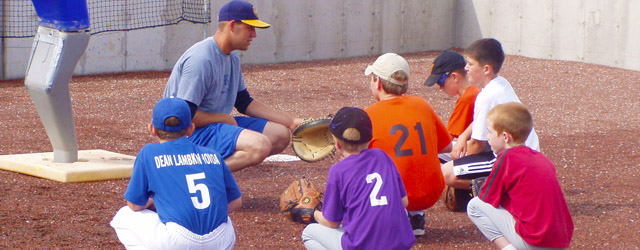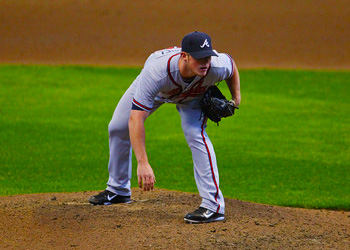
One of the first things many baseball players learn is how to give and read signs. After all, we can’t have coaches and players yelling out plays and pitches. That would give away your game plan and give a tremendous advantage to the opposing team. Some of the most basic signs are those that a catcher gives a pitcher when communicating on what pitch to throw to the hitter. You may recognize the most basic ones:
1 – Fastball
2 – Curveball
3 – Slider
4 (or wiggle) – Change-up
This system is simple and effective, and it has been around since the inception of the game. The only problem with this system comes when runners get on base, especially second, as they can see the signs and relay to the hitter the pitch that is coming. Obviously, this gives the hitter a big advantage if he knows what pitch is being thrown. Furthermore, a great base runner will try to pick up the sign so that he can get a jump on the pitch to try to steal the next base. The communication between the pitcher and catcher needs to be on point in these situations so as not tip their pitches to the other team.
Establish a System
The pitcher and catcher should establish a system to communicate the pitch type without being so confusing that the pitcher crosses up the catcher (i.e. throws him a curveball when the catcher thought a fastball was coming). You should practice at least two methods in case the opposing team picks up on your signs and you need to change your system mid-inning. Some suggested methods and how to implement them are listed below.
2nd Sign
This is as simple as it gets. The pitcher and catcher agree that the catcher will give a sequence of signs and the second one in the sequence is the pitch. All other signs mean nothing. So, if the catcher wants a slider he can flash the following sequence: 1-3-1-2-2-4. The only signal that matters is the second number – in this case 3, which is a slider. The sequence 3-1-4-2-2-1 would indicate fastball.
It does not always have to be the second sign. Catcher and pitcher can decide on the first sign, last sign, or whatever they are comfortable with. Just note, this is a very simple method which means it is easier for a base runner to break and therefore learn what pitch is coming. So be sure to mix it up, so long as you and your battery-mate are on the same page.
1st Sign Indicator
This method takes the system mentioned above and adds another level. In this system, the first number the catcher puts down indicates which sign will be used. For example, 3-2-3-1-4-2 would indicate to the pitcher that the catcher is calling for a fastball. The first number in the sequence, 3, tells the pitcher that the third sign after that number is the pitch. Here is another one with the indicator and actual pitch bolded to help you out: 2-3-2-1-4-1. Once again, the first 2 indicates which sign will be used, and the second 2 gives the actual pitch.
The beauty of this system is that the sign that gives the actual pitch varies in the sequence from pitch to pitch making it much more difficult for opposing players to break the code. Try this one out: 1-4-1-4-2-2 (answer at the end of this post).
Pump System
In the pump system the numbers the catcher is putting down mean absolutely nothing. Instead, treat each number as a pump and count the number of pumps to get your sign. Before we get right after it, we need to establish the number of pumps for each pitch. For our example, let’s use a similar system as before:
1 pump – Fastball
2 pumps – Curveball
3 pumps – Slider
4 pumps – Change-up
Now, you should be thinking, “What if there are more than four pumps?” The answer is simple, start back at the top of the list. Let’s try it out. If I wanted to call a curveball I could give something like this: 1-3-2-1-3-4. Remember, the number of fingers the catcher puts down mean nothing. It’s the number of times he flashes any sign (or pumps his hand open and close.) Give it a try: 4-2-1-1-2-3-2-1.
Alternate Indicator
If all that counting has you confused, you can use a different kind of indicator system. This one is simple and allows you to vary the order of the pitching signals from pitch to pitch. Pick any number and call that your indicator. For our purposes we’ll use the number 4. This means that the catcher can put down any number of signs he wants, but the real sign does not come until after the indicator – in this case a 4. So, a slider call would look like this: 2-1-1-3-4-3 or this 4-3-1-1-3-2. In both cases, the sign that follows the 4 is the actual pitch. Once again, you can pick any number you want for the indicator so long as pitcher and catcher are aware of the correct indicator. Try it out – the indicator is 3: 2-4-1-3-3-1.
Outs Plus One
If you want to get a little more complicated, you can go with this system whereby you take the number of outs and add one to indicate which sign will be the real one. It’s only complicated if either the pitcher or catcher forgets the number of outs. Otherwise, it’s easy to implement and breaks down like this:
0 out + 1 = 1st sign
1 out + 1 = 2nd sign
2 outs + 1 = 3rd sign
So with 1 out, if the catcher wants to call a fastball he would flash something like this: 2-1-3-1-1-3. With 2 outs, the same fastball can be called like this: 1-3-1-4-4-1. Give it a try. With 0 outs and a runner on base, the catcher gives the following sequence: 2-1-1-3-2-2. What’s the pitch?
Keep it Simple
Whether you use one of the systems mentioned above or come up with your own, just remember to not complicate the process. You want it simple enough for catcher and pitcher to both understand, but difficult enough that a runner on second cannot easily figure out the pitch. Most runners will need to see a multitude of pitches before they can figure out the system. However, if you find that they have been relaying signs to the hitter, just call timeout and change the system.
Check out Domingo Ayala’s sign system:
Did you figure what pitch was being called in each of the examples above? Here are the answers:
First Sign Indicator: 1-4-1-4-2-2 – Change-up
Pump System: 4-2-1-1-2-3-2-1 – Change-up
Alternate Indicator (indicator is 3): 2-4-1-3-3-1 – Slider
Outs Plus One (0 outs): 2-1-1-3-2-2 – Curveball

Leave a Reply